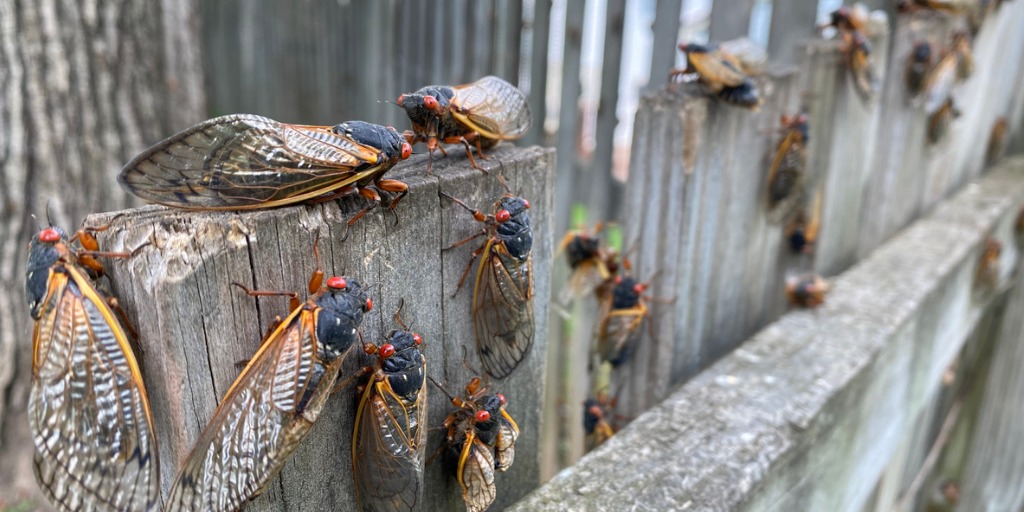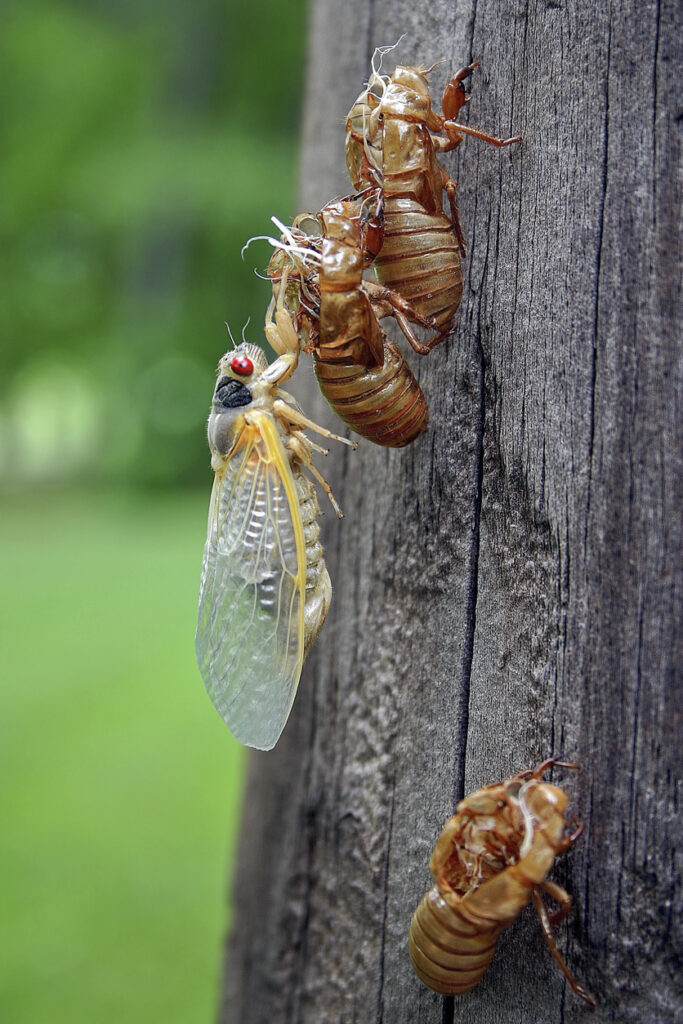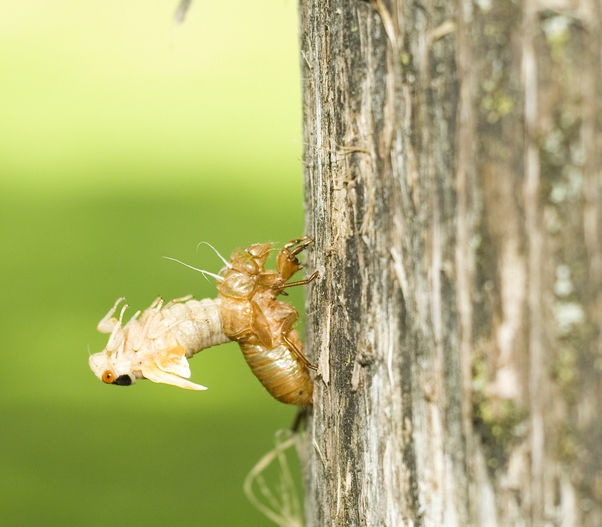| By Amy Hackney Blackwell |
This May and June will see an entomological event that occurs only once every 221 years. Two broods of periodical cicadas are now digging their way out of their subterranean homes. One brood consists of cicadas that emerge every 17 years. The other is cicadas on a 13-year cycle. The last time these two broods arrived simultaneously was in 1803 and it won’t happen again until 2245.
The great cicada event has already begun. The first insects emerged from their underground homes in late April in some southern states. By the time the last adults die in late July, trillions of cicadas will have dug their way out and sung their songs en masse.
Cicadas versus Locusts
Some people believe cicadas are locusts, but this is inaccurate. Locusts are actually a type of grasshopper in the order Orthoptera. For example, the locusts that famously destroyed the Ingalls family’s farm in the Little House on the Prairie books were grasshoppers of the species Melanoplus spretus, also called the Rocky Mountain locust. These grasshoppers swarmed in great numbers during the 19th century. Their underground eggs hatched into young grasshoppers that ate every bit of green matter they could find, leaving devastation in their wake. Like cicadas, these grasshoppers appeared sporadically, leaving farmers at a loss as to when they would next emerge. The Rocky Mountain locust went extinct around 1900.
Cicadas are not locusts—they’re in a completely different taxonomic order, Hemiptera. European colonists who came to North America in the early 1700s started calling cicadas locusts because of their superficial resemblance to insects described in the Bible, and the name has stuck, but cicadas are completely different from locusts. Far from being a plague, cicadas are actually ecologically beneficial.
Though cicadas do appear en masse like locusts, with millions of insects emerging at the same time, they don’t fly around in swarms that travel the country together. Unlike locusts, cicadas present no danger to most plants, though they can damage young trees if large numbers feed on them. They’re not poisonous, and in fact, they’re a great source of food for birds and other predators. Young cicadas (or nymphs) aerate the soil, while dead cicadas are natural plant fertilizers.
Many people even eat cicadas; aficionados recommend eating them when they’re still white, just after they emerge from the soil and undergo their final molt. They reportedly taste like canned asparagus.
True, some people find cicadas ugly to look at, but that’s just personal preference. Some find their songs irritating and loud. Some cicadas have been measured singing as loud as 100 decibels, which can be compared to the noise level produced by a chainsaw. Millions of cicada males singing at the same time can create quite a racket!
Cicada Life Cycle
All cicadas follow a similar life cycle. They hatch from eggs laid in the bark of tree branches and drop to the ground. The nymphs burrow into the soil, where they spend their time sucking fluids from the vascular tissue in tree roots. When they’re fully grown, and the soil warms up to about 64 degrees Fahrenheit (18 degrees Celsius) around 12 inches (30 centimeters) below the surface, the nymphs dig their way up to the surface and undergo their final molt. This is when they leave behind the clawed exoskeletons that cling to tree trunks. The cicadas then spend about six weeks in their winged adult forms. The adult males sing loud songs to attract females. Males die after mating, and the females die after laying eggs.
The main variable in this pattern is how long nymphs stay underground. Many species are annual cicadas, which emerge the spring after they are laid, and they complete their lives in about a year. But some cicada species, known as periodical cicadas, live underground for much, much longer.
The 2024 broods are both periodical cicadas. Three of the species of periodical cicadas endemic to North America live on a 17-year cycle, and four species live on a 13-year cycle. All nymphs from a single large group, or brood, emerge at about the same time. There can be up to 30 cicadas per square foot (0.09 square meters) and millions in one acre (0.4 hectares). Emerging en masse is essentially cicadas’ only defensive strategy; with so many insects, the odds of an individual surviving being eaten improve substantially.
Broods XIII and XIX
Scientists who track cicadas name broods with Roman numerals. The broods emerging this year are Brood XIII and Brood XIX.
Brood XIII, also known as the Northern Illinois Brood, is a brood of 17-year cicadas that last appeared in 2007. This brood includes cicadas from three species: Magicicada cassini, Magicicada septendecim, and Magicicada septendecula. Brood XIII will emerge in northern Illinois, southern Wisconsin, and eastern Iowa. A few insects will also emerge in the northwest corner of Indiana.
Brood XIX, the Great Southern Brood, is a brood of 13-year cicadas that will emerge throughout the Southeast. It hasn’t been seen since 2011. Brood XIX contains cicadas from the species Magicicada neotredecim, Magicicada tredecim, Magicicada tredecassini, and Magicicada tredecula.
Brood XIX has a much more extensive geographic range. Brood XIX cicadas are expected to emerge in the following states:
- Alabama
- Arkansas
- Georgia
- Illinois
- Iowa
- Louisiana
- Oklahoma
- Maryland
- Mississippi
- Missouri
- North Carolina
- South Carolina
- Tennessee
- West Virginia
Brood XIX might geographically overlap with Brood XIII in Illinois and Iowa, but for the most part, Brood XIX will emerge in completely different locations.
The first Brood XIX cicadas started appearing in late April in the southernmost reaches of the range. Emergence will work its way northward as soil temperatures rise throughout the spring. The cicada fan sight CicadaMania.com as well as iNaturalist.com are publishing maps of observations as they are reported.
Go on a Cicada Safari
Scientists want to track as much of this double emergence as they can, and they need help! This is a perfect occasion for citizen science. Scientists can’t possibly be everywhere cicadas come out of the ground, so they’re hoping that ordinary people will help them gather data.
One way to help is by downloading the free Cicada Safari app, developed by Ohio entomologist Gene Kritsky in 2019. This app, available at the Apple App Store and Google Play, is simple to use. A person who sees a cicada simply takes a photo of it. Scientists can then compile these photos to create a map of dates and locations where cicadas are emerging. Sending in photos allows the scientists running the program to verify that the insects are indeed the correct periodical cicadas.
The Cicada Safari app has already been deployed to track small broods that emerged in 2019 and 2020. The collected data contained several surprises, including cicadas emerging out of cycle and far from where they were expected to be. Dr. Kritsky and his team hope for a great collection of citizen science data in 2024.
The iNaturalist app also allows citizen scientists to report sightings of various species. It’s not specific to cicadas, but anyone who already has it installed can contribute to cicada tracking. Check the iNaturalist website for the most current reports of cicada sightings.
This data could result in new discoveries. For instance, it’s not known whether the two separate broods might interbreed. If they do, this could potentially lead to the creation of a new brood of cicadas. There’s also the concern that cicada populations might have dropped since the last time they emerged; the landscape has changed due to construction, paving, and tree removal, which might well affect insect numbers.
Anyone who hasn’t yet made summer travel plans might consider a trip to areas where the cicadas are expected to emerge. Cicada enthusiasts have already been planning their journeys to see this rare event.
And anyone living in areas where the cicadas are native should consider themselves lucky! It’s an incredible experience to see even a small part of a natural phenomenon that only occurs once in a human lifetime.

About the Author
Amy Hackney Blackwell’s research areas include plant conservation, historical botany, and the international legal regime governing the ownership of genetic resources. She lives in South Carolina with her family and several cats.



